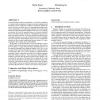145 search results - page 11 / 29 » Automated Detection of Code Vulnerabilities Based on Program... |
LICS
2009
IEEE
14 years 2 months ago
2009
IEEE
In this paper we introduce “clipping,” a new method of syntactic approximation which is motivated by and works in conjunction with a sound and decidable denotational model for...
ISSTA
2010
ACM
13 years 11 months ago
2010
ACM
Dynamic loading of software components (e.g., libraries or modules) is a widely used mechanism for improved system modularity and flexibility. Correct component resolution is cri...
KBSE
2005
IEEE
14 years 1 months ago
2005
IEEE
Concurrent programs are notorious for containing errors that are difficult to reproduce and diagnose. Two common kinds of concurrency errors are data races and atomicity violation...
SP
2010
IEEE
13 years 11 months ago
2010
IEEE
—To handle the growing flood of malware, security vendors and analysts rely on tools that automatically identify and analyze malicious code. Current systems for automated malwar...
TPHOL
2008
IEEE
14 years 1 months ago
2008
IEEE
Systems that can immediately react to their inputs may suffer from cyclic dependencies between their actions and the corresponding trigger conditions. For this reason, causality an...

